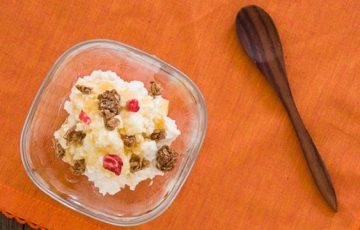
Ricotta, which literally means “recooked” in Italian, is a fresh cheese that’s so easy to make, there’s really no reason to buy it premade in stores. It’s a versatile ingredient that’s used in the filling for ravioli, and can be used to make a tender, flavorful gnocchi-like dumpling called Malfatti. But perhaps my favorite way of having it is in a bowl drizzled with a little good honey and a generous sprinkle of granola for breakfast.


Ricotta was originally created as a way to reclaim additional protein from the whey leftover after making cheese, but it’s even better if you make it from fresh milk. While low-fat or non-fat milk will work, it won’t taste as good and you’ll end up getting much less yield, which is why I recommend using whole fat milk and then adding some extra cream to increase the fat content. Ideally you want to use very fresh milk that has not been Ultra-Pasteurized (UHT). Ultra-Pasteurization kills bacteria in milk by heating it to extremely high temperatures for a short amount of time. While this extends the shelf life of milk, it ruins the flavor and changes the structure of the proteins in milk making it nearly impossible to get a good curd out of the milk.

While any acid such as lemon juice or vinegar will work as the curdling agent, I like using citric acid because it is more predictable (lemons vary in acidity) and results in a more neutral tasting ricotta. This allows you to enjoy the taste of the quality milk you’re using, rather than the taste of the curdling agent.


Lastly, depending on how you plan to use this, you can drain it for a little or a long time, which will affect the water content and texture of the ricotta. The less time the ricotta spends draining, the creamier it tends to be, which makes it great for eating, but if you plan to use this in a batter or dough, it’s best to drain it longer so that the extra water doesn’t change the ratio of flour to water in your recipe.

Fresh Ricotta

Prepare this versatile cheese to eat on its own or use as an ingredient in another dish.
(Recipe Courtesy: Marc Matsumoto from the Fresh Tastes blog)
- 1/4 cup water
- 1/2 teaspoon citric acid
- 4 cups whole milk
- 1/2 cup heavy cream
- 1/2 teaspoon salt
Ingredients
- In a small non-reactive bowl, mix the water and citric acid until the granules are dissolved.
- Pour the milk, cream and salt into a heavy bottomed pot and whisk in half of the citric acid mixture until well combined.
- Heat the pot over medium heat, stirring regularly, until it reaches 165 degrees F. You should start seeing some small grains of curd forming. If there is no curd, add more of the citric acid a bit at a time until you start to see curds forming. Be careful not to add too much, otherwise your ricotta will taste sour.
- Once the curds have started to form, turn down the heat and stop mixing. Disturbing the mixture prevents the curds from forming, but you need to lower the heat to keep it from burning to the bottom of the pan.
- Continue heating the mixture until it reaches 195 degrees F, and then turn off the heat. Let this rest for 15 minutes.
- You should now have a thick layer of curd floating on the surface.
- Use a screened ladle to scoop the curd into a paper towel lined sieve. If everyting has gone well, you should be left with a translucent yellow liquid, which is the whey. You can save it for something else, or toss it.
- Let the ricotta strain over a bowl until it reaches your desired consistency. The longer you let it drain the dryer and more crumbly it will become. The author recommends only letting it drain for a few minutes to achieve a creamy ricotta.
Directions
Yield: 1 1/2 cups of ricotta
 Marc Matsumoto is a culinary consultant and recipe repairman who shares his passion for good food through his website norecipes.com. For Marc, food is a life long journey of exploration, discovery and experimentation and he shares his escapades through his blog in the hopes that he inspires others to find their own culinary adventures. Marcs been featured in the New York Times, Wall Street Journal, and USA Today, and has made multiple appearances on NPR and the Food Network.
Marc Matsumoto is a culinary consultant and recipe repairman who shares his passion for good food through his website norecipes.com. For Marc, food is a life long journey of exploration, discovery and experimentation and he shares his escapades through his blog in the hopes that he inspires others to find their own culinary adventures. Marcs been featured in the New York Times, Wall Street Journal, and USA Today, and has made multiple appearances on NPR and the Food Network.


